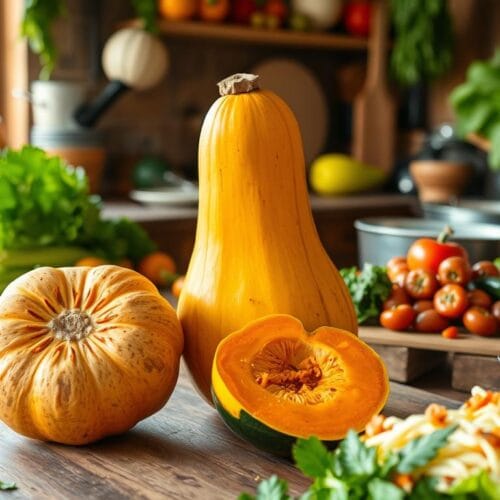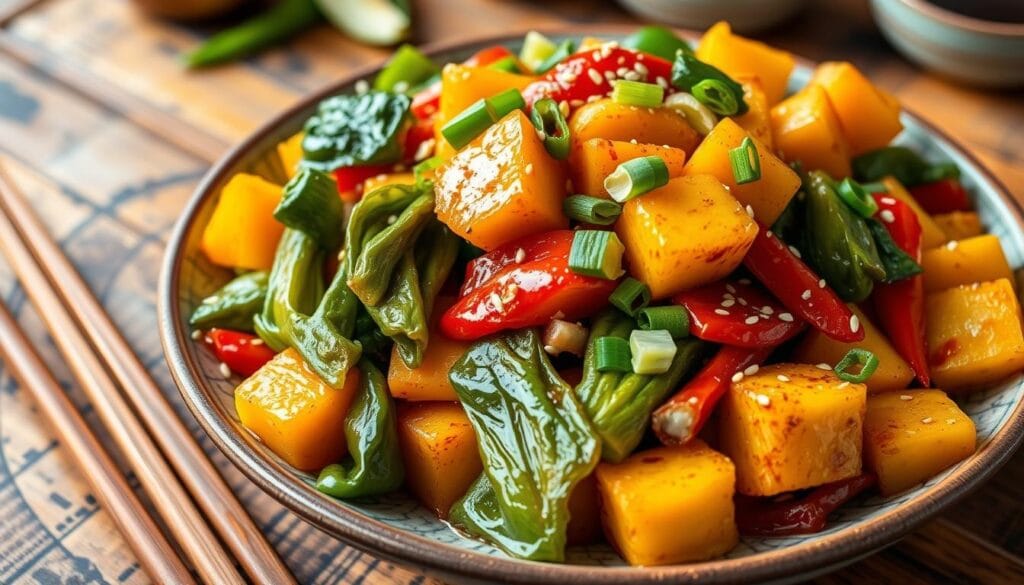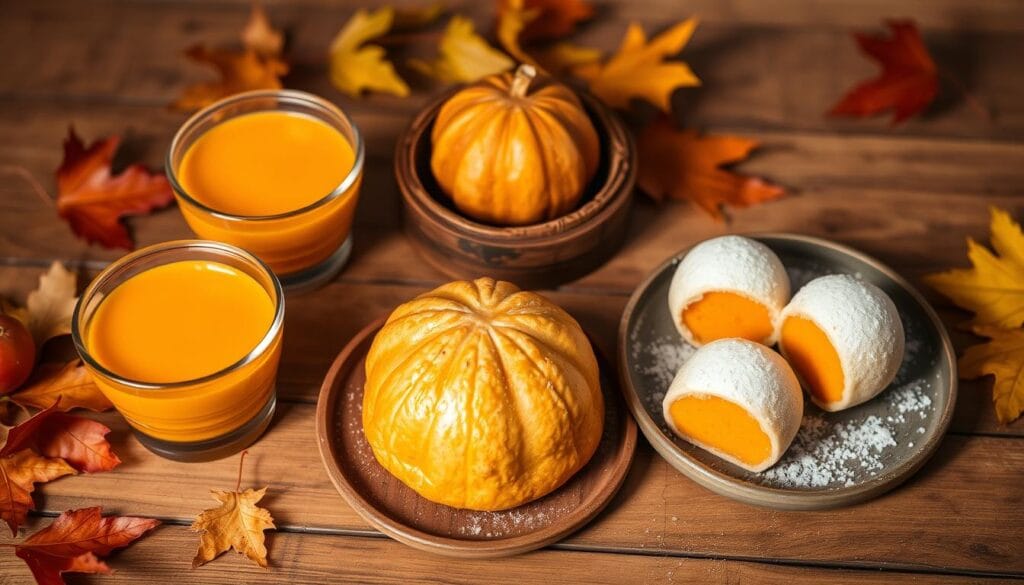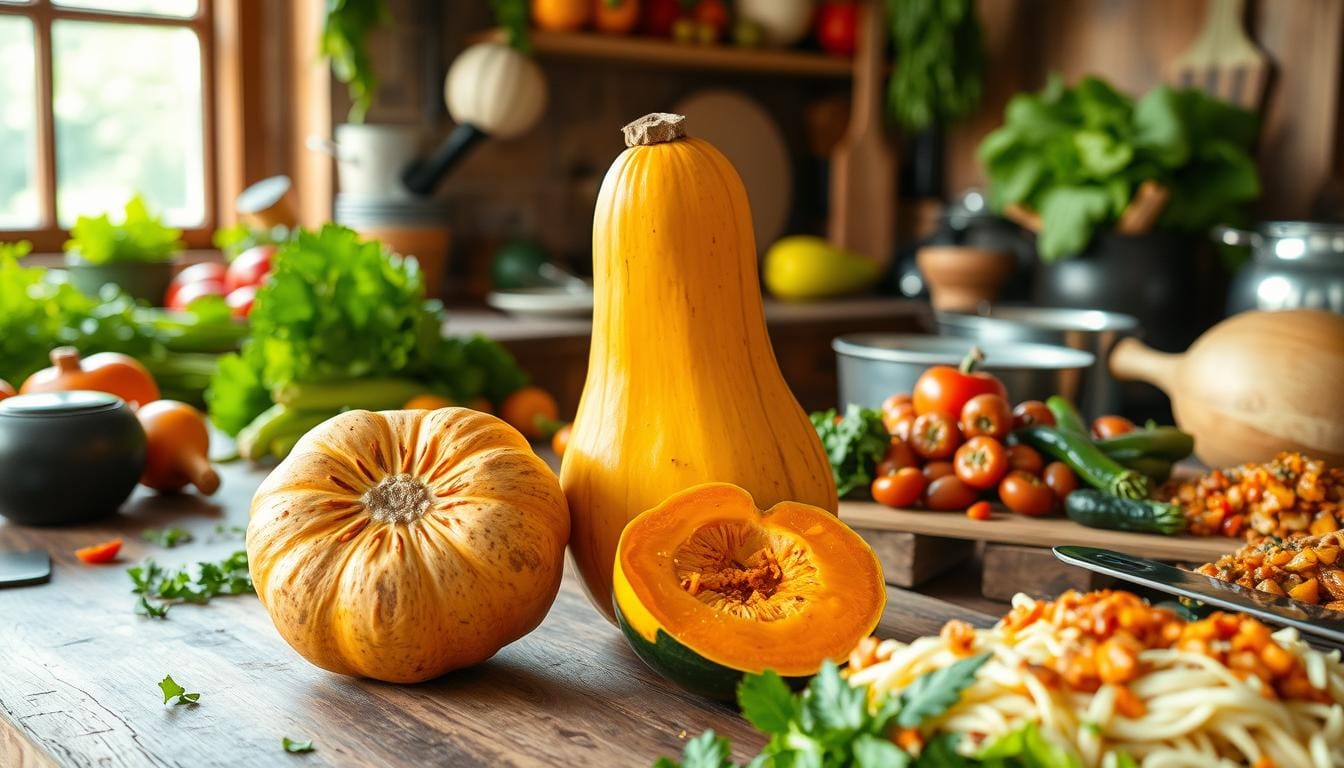
How to Make Chinese Squash Recipes Kabocha Vegan
Equipment
- 1 Pan or Wok
- 1 Cutting board
- 1 Knife
- 1 Measuring Spoons
- 1 Spatula or Wooden Spoon
- 1 Garlic Press (optional)
- 1 Serving plates
- 1 Small Bowl (optional)
- 1 Grater (optional)
Ingredients
- 1 medium Kabocha squash
- 2 tbsp vegetable oil
- 2 cloves garlic
- 1 small onion
- 1 red bell pepper
- ½ cup baby bok choy
- 2 tbsp soy sauce
- 1 tbsp rice vinegar
- 1 tbsp sesame oil
- 1 tsp chili paste
- ½ tsp ground ginger
- 1 tbsp sesame seeds
- Fresh cilantro
Instructions
- Prepare the Squash: Peel, seed, and cube the Kabocha squash into bite-sized pieces. Set aside.
- Sauté the Vegetables: In a large pan or wok, heat the vegetable oil over medium heat. Add the garlic and onion. Sauté until fragrant and the onion becomes translucent (about 2-3 minutes).
- Cook the Squash: Add the Kabocha squash cubes to the pan. Stir-fry for 5-7 minutes until they begin to soften. You can cover the pan for a few minutes to speed up the cooking process.
- Add the Vegetables: Add the red bell pepper, baby bok choy, and ground ginger (if using). Stir everything together and cook for an additional 3-4 minutes, or until the vegetables are tender.
- Season: Stir in the soy sauce, rice vinegar, and sesame oil. If you like it spicy, add a teaspoon of chili paste. Toss everything together until well-coated.
- Garnish and Serve: Once everything is cooked through and well-mixed, remove from heat. Garnish with sesame seeds and fresh cilantro.
- Serve: Enjoy your Chinese Kabocha Squash Stir-Fry as a standalone dish or served with steamed rice.
Video
Exploring chinese squash recipes kabocha vegan changed my cooking world. The first time I cut into a green kabocha squash, its orange flesh opened up new cooking possibilities. It changed how I cook plant-based meals.
Cooking with kabocha squash is more than just making food. It’s about using a versatile ingredient that mixes traditional Asian cooking with vegan methods. This Japanese pumpkin adds a sweet and nutty taste that makes any dish special.
Whether you’re a pro at vegan cooking or new to it, kabocha squash is a great place to start. It’s full of vitamins A and C, potassium, and fiber. It’s not just tasty, but also super healthy.
In this guide, you’ll discover how to make amazing vegan dishes with kabocha squash. These dishes will wow anyone. Get ready to learn the secrets of chinese squash recipes kabocha vegan and take your cooking to the next level.
Table of Contents
Understanding Kabocha Squash: A Versatile Japanese Pumpkin
Kabocha squash, also known as Japanese pumpkin, is a nutritional powerhouse. It has captured the hearts of many who love vegetarian kabocha recipes. This squash offers both amazing flavor and health benefits.
Exploring kabocha squash baked whole reveals a remarkable ingredient. It’s packed with essential nutrients. One cup of roasted kabocha squash has about 80 calories and a great nutritional profile.
Nutritional Powerhouse
Let’s look at the amazing nutritional benefits of kabocha squash:
- Rich in Vitamin A: 1552 IU supporting eye health
- Excellent Vitamin C source: 14 mg boosting immunity
- High Potassium: 455 mg promoting heart health
- Good Fiber: 2g supporting digestive wellness
Kabocha squash is low in calories, making it perfect for health-conscious cooks. Its sweet, nutty flavor makes it versatile in vegetarian kabocha recipes.
Unique Culinary Properties
Kabocha squash has a dense, smooth texture. It absorbs flavors well. You can roast, steam, or use it in soups, and it works great.
Best of all, kabocha squash is available all year but is sweetest in fall and early winter. It’s a favorite for plant-based cooking during these seasons.
Essential Kitchen Tools and Ingredients for Chinese Squash Recipes
Making tasty asian pumpkin dishes needs more than skill – it requires the right tools and ingredients. When you start with chinese kabocha curry or other squash recipes, your kitchen tools are key. They help bring out authentic flavors.
Here are the main kitchen tools for working with kabocha squash:
- Sharp chef’s knife
- Cutting board
- Heavy-bottomed wok
- Steamer basket
- Roasting pan
To make amazing vegan Chinese squash recipes, make sure you have these ingredients:
- Soy sauce – adds umami flavor
- Rice vinegar
- Sesame oil
- Fresh ginger
- Garlic
- Soft tofu
Knowing about nutrition helps your cooking. Kabocha squash is packed with benefits. One cup has over 1,100 micrograms of beta carotene and about 18% of daily vitamin C. It also has 5 grams of dietary fiber per cup, which is great for digestion and keeps meals filling.
Pro tip: Always pick fresh, high-quality ingredients for your dishes. Your chinese kabocha curry will have rich, true flavors. These flavors will take your taste buds straight to traditional kitchens.
Preparing Kabocha Squash for Vegan Chinese Cooking
Kabocha squash, also known as Japanese pumpkin, is a key ingredient in vegan Chinese dishes. It’s essential to know how to prepare it well. This guide will show you how to handle this nutritious squash.
Cleaning and Cutting Techniques
Preparing kabocha squash needs precision and care. Here’s how to do it right:
- Wash the squash under cool running water
- The top and bottom should be cut off using a sharp knife
- Apply a vegetable peeler to the rough outer skin to remove it
- Scoop out the seeds after halves the squash
- Cube or slice the squash as needed
Pre-cooking Methods
There are different ways to pre-cook kabocha squash. Roasting at 400°F (200°C) for 25-30 minutes makes it sweet. Steaming for 15-17 minutes also works well.
Seasoning Basics
For great flavor in your vegan Chinese dishes, try these tips:
- Use sesame oil for a true Chinese taste
- Add soy sauce for depth of flavor
- Try roasted kabocha seeds as a crunchy topping
- Use spices like five-spice powder or cinnamon
- Balance flavors with a bit of sriracha
Pro tip: Don’t throw away the kabocha seeds! Roast them with salt for a tasty snack that goes well with your meal.
Chinese Squash Recipes Kabocha Vegan: Classic Preparations
Explore the world of authentic chinese squash recipes kabocha vegan. Here, traditional cooking meets plant-based innovation. Kabocha squash adds a unique sweetness and rich texture to classic Chinese dishes. It turns them into delightful vegan culinary experiences.
Kabocha squash is versatile in various classic Chinese preparations. Its deep green skin and vibrant orange flesh make it a nutritional powerhouse. Traditional techniques can be adapted to create mouth-watering plant-based meals. These celebrate the squash’s natural flavors.
- Stir-fried kabocha with ginger and garlic
- Kabocha noodles with savory seasonings
- Steamed kabocha dumplings
- Hot pot featuring kabocha as a primary ingredient
When preparing kabocha for Chinese-inspired vegan dishes, consider these key cooking methods:
- Cubing: Create uniform pieces for even cooking
- Steaming: Preserve nutrients and maintain a soft texture
- Stir-frying: Develop deep, caramelized flavors
- Roasting: Enhance natural sweetness
Mastering kabocha noodles requires understanding the squash’s unique properties. Its naturally sweet flavor pairs well with traditional Chinese seasonings. Whether you’re making a quick stir-fry or a complex noodle dish, kabocha offers endless possibilities for vegan Chinese cuisine.
Miso Soy Glazed Roasted Kabocha Recipe
Discover a delicious vegetarian kabocha recipe that turns this Japanese pumpkin into a tasty main dish. Roasting the kabocha squash whole brings out its sweet flavor. It also creates a crispy outside that will wow your guests.
This recipe mixes Asian flavors with a simple roasting method. It makes kabocha a gourmet dish. The secret is the special glaze that adds deep, umami flavors.
Glaze Preparation Steps
Creating the perfect glaze is key for this recipe. You’ll need:
- 2 Tbsp white miso paste
- 1 Tbsp soy sauce
- 2 Tbsp rice vinegar
- 2 Tbsp maple syrup
- 1 Tbsp sesame oil
- 1/2 tsp garlic powder
Roasting Instructions
To roast the kabocha squash perfectly, follow these steps:
- Preheat oven to 425°F
- Wash and cut kabocha squash into 1-inch thick wedges
- Brush squash with avocado oil
- Whisk glaze ingredients until smooth
Roast the squash for 35-40 minutes, flipping halfway. Brush with glaze in the last 10 minutes for a caramelized outside.
Serving Suggestions
| Serving Option | Pairing Recommendations |
|---|---|
| Appetizer | Serve with green onion garnish |
| Main Course | Pair with steamed rice or quinoa |
| Side Dish | Sprinkle with toasted sesame seeds |
Pro tip: Let the roasted kabocha rest for 5 minutes before serving. This allows the flavors to fully develop. This recipe serves 4 and can be easily doubled for more guests.
Stir-fried kabocha with Asian Seasonings
Kabocha stir fry is a tasty way to enjoy Asian pumpkin dishes. It combines sweet and savory flavors from Chinese cooking. This squash turns into a delicious meal.

To make your kabocha stir fry, focus on steps that bring out its sweetness. Choose a fresh kabocha that’s 2-3 pounds for the best taste.
Essential Ingredients
- Cubed kabocha squash
- Firm tofu
- Low-sodium soy sauce
- Sesame oil
- Rice vinegar
- Fresh ginger
- Garlic cloves
- Optional: Chili flakes
Cooking Technique
For a great stir fry, cook at high heat and quickly. Cook your ingredients for 6-10 minutes. This keeps them crisp and flavorful.
| Ingredient | Quantity | Preparation |
|---|---|---|
| Kabocha Squash | 12 ounces | Cubed |
| Tofu | 8 ounces | Pressed and cubed |
| Soy Sauce | 1/4 cup | Low sodium |
Soak your ingredients in salted water for 15 minutes. This helps them absorb less oil and taste better.
Serving Suggestions
Your kabocha stir fry goes well with steamed rice or on its own. It serves 2-3 people. You can keep it in the fridge for up to 5 days, making it great for meal prep.
Kabocha Squash Curry with Chinese Influences
Explore the world of vegetarian kabocha recipes with this Chinese kabocha curry. It combines rich flavors and a comforting warmth. The kabocha squash’s unique sweetness is perfect for a hearty, spice-packed curry.
Making an authentic Chinese kabocha curry needs careful attention. It’s all about balancing the squash’s sweetness with bold spices. This creates a complex flavor profile.
Sauce Base Components
Your curry’s foundation starts with the right ingredients. Here are the essential components:
- Full-fat coconut milk (½ cup)
- Vegetable broth (4 cups)
- Fresh ginger, minced
- Garlic cloves
- Chinese five-spice powder
Cooking Process
Follow these key steps for your vegetarian kabocha recipes:
- Prep 2 pounds of kabocha squash, cutting into ½-inch pieces
- Sauté onions until translucent (8-10 minutes)
- Add spices and aromatics
- Incorporate squash and broth
- Simmer for 15-20 minutes until squash becomes tender
For an extra kick, sprinkle up to ¼ teaspoon of red pepper flakes. Finish with a tablespoon of fresh lime juice. This will brighten the flavors and make your Chinese kabocha curry unforgettable.
Vegan Kabocha Noodle Dishes
Exploring kabocha noodles opens a world of vegan cooking. These vibrant dishes turn the humble Japanese pumpkin into an amazing noodle experience. They delight both vegans and food lovers.
Kabocha squash adds a unique sweetness and creamy texture to noodles. You can make stunning vegan dishes with it. These dishes show off the versatile ingredients in exciting ways.
- Spiralized kabocha noodles as a pasta replacement
- Roasted kabocha cubes mixed with traditional wheat noodles
- Pureed kabocha sauce coating rice or glass noodles
When cooking kabocha noodles, keep these tips in mind:
- Slice kabocha into thin, uniform strips for consistent cooking
- Season with tamari, ginger, and garlic for authentic Chinese flavors
- Experiment with different noodle types like rice, udon, or soba
Your vegan Chinese squash recipes can be light summer dishes or hearty winter meals. The secret is knowing kabocha’s rich, sweet flavor. Pair it with seasonings that bring out its natural taste.
Creative Ways to Use Kabocha in Chinese Desserts
Exploring kabocha desserts opens a world of sweet treats. This versatile squash is perfect for making innovative Chinese-inspired desserts. Its natural sweetness makes it a delight to work with.
Traditional Sweet Soup Delights
Kabocha is a star in traditional Chinese sweet soups or tong sui. These desserts are creamy and warm, perfect for cozying up. Here’s how to make them:
- Simmer diced kabocha in coconut milk
- Add ginger for subtle warmth
- Sweeten with rock sugar or maple syrup
- Garnish with toasted sesame seeds
Innovative Baked Kabocha Treats
Vegan bakers can make amazing kabocha desserts. Try these creative ideas for a twist on traditional sweets:
- Kabocha mooncakes with sweet bean filling
- Steamed kabocha dumplings
- Roasted kabocha custard tarts
- Kabocha mochi with coconut cream

When baking kabocha desserts, roast it at 400°F for 25-35 minutes. This brings out its sweetness. Add fall spices like cinnamon and nutmeg for extra flavor in your vegan Chinese treats.
Tips for Achieving Perfect Texture and Flavor
Mastering vegetarian kabocha recipes means understanding its unique traits. This Japanese pumpkin is sweet and creamy when cooked right. It’s a great addition to vegan Chinese dishes.
Here are key techniques for cooking kabocha squash:
- Roast at 400°F for 25-30 minutes to caramelize natural sugars
- Avoid overcooking to prevent a mushy texture
- Keep the skin on, as it becomes tender during cooking
- Use minimal seasoning to highlight squash’s natural sweetness
Different cooking methods change kabocha’s texture:
| Cooking Method | Texture Result | Flavor Enhancement |
|---|---|---|
| Roasting | Caramelized exterior | Intensified sweetness |
| Steaming | Soft and moist | Preserved natural flavor |
| Stir-frying | Slightly crisp edges | Absorbs seasonings quickly |
Seasoning is key to enhancing kabocha’s flavor. The traditional five-spice powder can make your vegetarian kabocha recipes stand out. It adds depth and complexity.
Pro tip: Store kabocha in a cool, dark place at 55-65°F for up to 3 weeks. This keeps its quality and nutritional value.
Common Mistakes to Avoid When Cooking Vegan Kabocha
Cooking kabocha squash can be tricky, especially when making vegan Chinese squash recipes. Many home cooks face challenges that can ruin the dish’s flavor and texture.
Here are the most critical mistakes to avoid:
- Improper cutting technique: Always use a sharp knife and cut kabocha squash carefully to maintain consistent piece sizes
- Overlooking seasoning balance in vegan Chinese squash recipes
- Cooking at incorrect temperatures
- Neglecting squash preparation methods
Understanding these potential pitfalls will help you create delicious vegan kabocha dishes with authentic Chinese flavors.
| Mistake | Solution |
|---|---|
| Overcooking | Monitor cooking time, aim for tender but firm texture |
| Under-seasoning | Use robust Asian-inspired spices and marinades |
| Incorrect storage | Store at 40-45°F, use within 5 days of cutting |
Remember, cooking kabocha squash needs patience and practice. Each try will make you better at making tasty vegan Chinese squash recipes.
Conclusion
Your journey into Chinese squash recipes kabocha vegan has opened up a world of tasty options. This versatile ingredient is packed with nutrition and flavor, making your plant-based meals special. It’s a powerhouse of health, providing 105% of daily Vitamin A and 45% of Vitamin C per serving.
Recipes and techniques show how kabocha can shine in many vegan dishes. It works well in roasted glazes, stir-fries, and curries. With only 30 calories per 100g and high fiber, it’s perfect for healthy, filling meals.
Kabocha squash is great for both seasoned vegan cooks and beginners. It invites you to try new things and create your recipes. Your culinary journey is just starting, and kabocha is ready to spark your next dish.
Cooking is about exploring, being creative, and enjoying the journey. Share your kabocha dishes with friends and keep learning. The vegan world of pumpkin dishes is full of possibilities, and you’re ready to dive in.


1 thought on “How to Make Chinese Squash Recipes Kabocha Vegan”
Comments are closed.